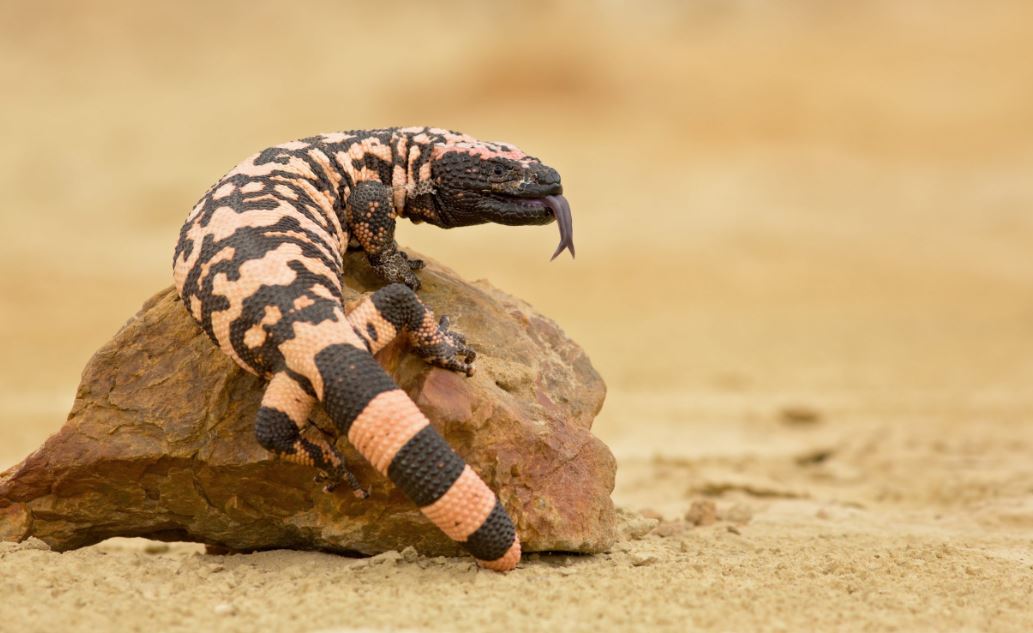North America boasts a diverse array of reptiles, ranging from the formidable American crocodile to the leisurely desert tortoise. Prepare to be amazed as we present a compilation of captivating pictures and intriguing information about some of the most remarkable reptiles found in this region.
Included in the following compilation are reptiles predominantly found in the United States, with a few species also inhabiting Canada and Mexico. We have carefully selected both familiar and lesser-known reptiles to provide you with a comprehensive overview of the reptilian life in the United States and its neighboring countries.
Were you aware that a lizard has the astonishing ability to squirt blood from its eyes, or that a turtle employs its tongue as bait to catch fish? Delve into the fascinating world of the Texas horned lizard and the alligator snapping turtle to discover more.
Exploration of American Reptiles: Engaging Pictures and Intriguing Details
1. Alligator Snapping Turtle
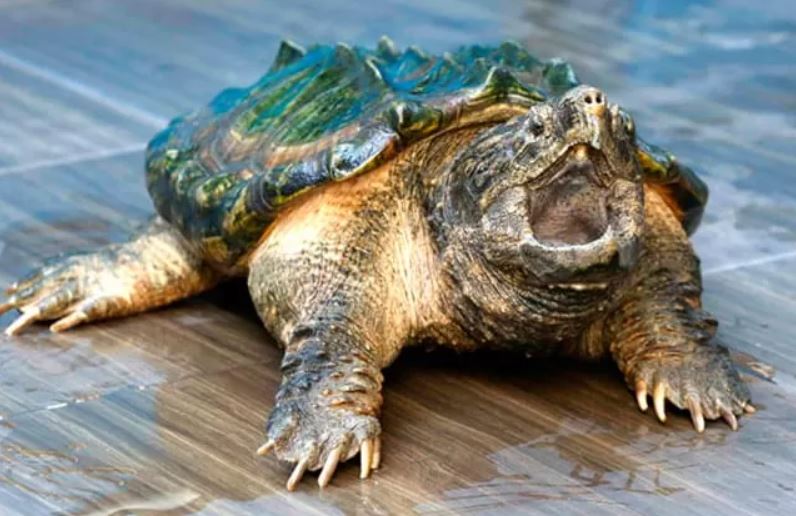
- Scientific Name: Macrochelys temminckii
- Conservation Status: Vulnerable
- Habitat: Southeastern United States
The alligator snapping turtle, known as the world’s largest freshwater turtle, possesses distinct characteristics that set it apart from its relative, the snapping turtle. Its impressive size and ridged shell, resembling the texture of an alligator’s skin, differentiate it from its cousin.
What sets the alligator snapping turtle apart is the worm-like extension at the tip of its tongue. This peculiar adaptation serves as bait, luring fish closer to its powerful jaws.
2. American Alligator
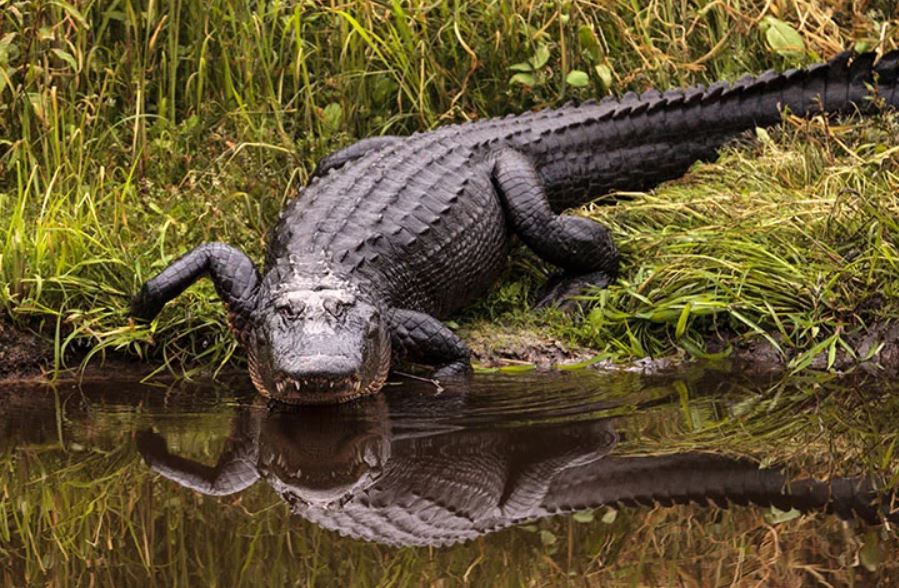
- Scientific Name: Alligator mississippiensis
- Conservation Status: Least Concern
- Habitat: Southeastern United States
No compilation of American reptiles would be complete without mentioning the American alligator. It holds the distinction of being the largest among the two alligator species worldwide (the other being the Chinese alligator). Males can grow up to an impressive length of 15 feet (4.6 meters).
While the American alligator may be the ruler among its alligator counterparts, it falls slightly short in size when compared to the American crocodile, a species it shares the southernmost part of its range with. Distinguishing features of the American alligator include its darker coloration and blunter snout.
This species primarily inhabits freshwater environments and exhibits a broad dietary range, consuming fish, birds, mammals, and other reptiles.
3. American Crocodile
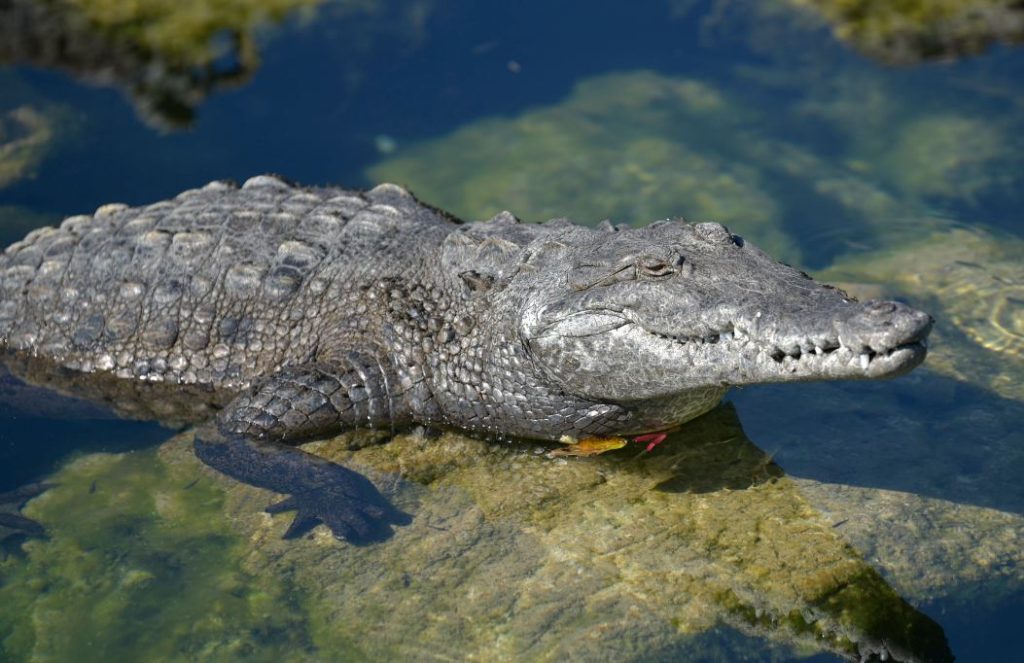
- Scientific Name: Crocodylus acutus
- Conservation Status: Vulnerable
- Habitat: South America, Central America, Florida
The American crocodile, a sizable reptile, can be found in northern South America, Central America, and also has a presence in southern Florida. Interestingly, it shares a habitat range with the American alligator in certain areas.
Distinguished by its pale grey-green skin and pointed snout, the male American crocodile typically reaches lengths of up to 16 feet (4.8 meters), although larger individuals have been observed. It primarily resides in coastal areas and some rivers, thriving in brackish and saltwater environments. Its diet encompasses fish, mammals, reptiles, and birds.
To delve deeper into the world of the American crocodile, explore our comprehensive page: American Crocodile Facts.
4. Carolina Anole
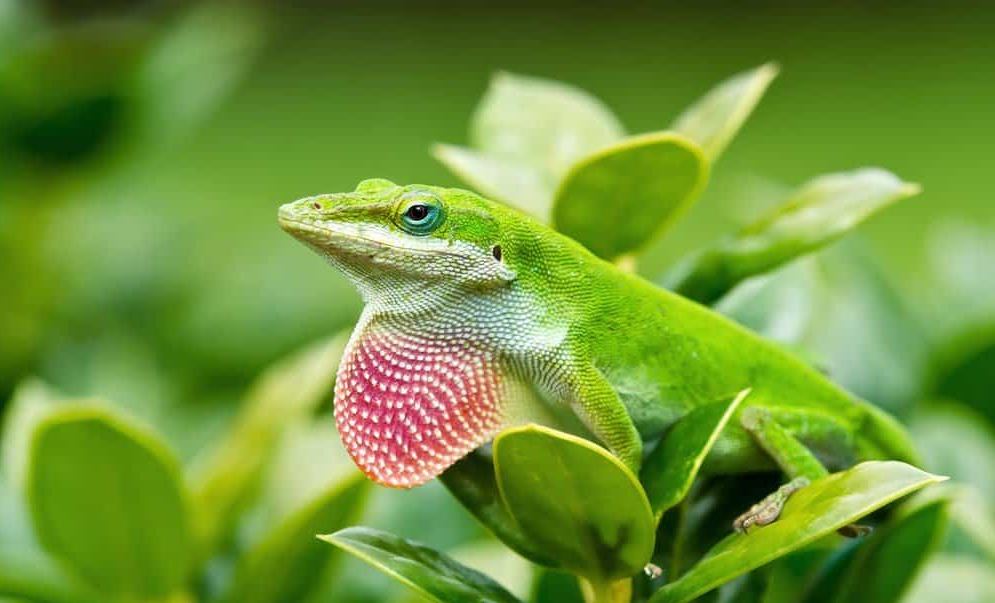
- Scientific Name: Anolis carolinensis
- Conservation Status: Least Concern
- Habitat: Southeastern United States
The Carolina anole, a small lizard, showcases animpressive length of approximately 8 inches (20 cm). Also known as the American chameleon due to its color-changing ability (although it is not a true chameleon), the Carolina anole typically displays vibrant shades of green or brown.
This arboreal species can be found predominantly in trees but is also spotted on fences and walls, showcasing its versatility in habitat selection.
5. Common Box Turtle
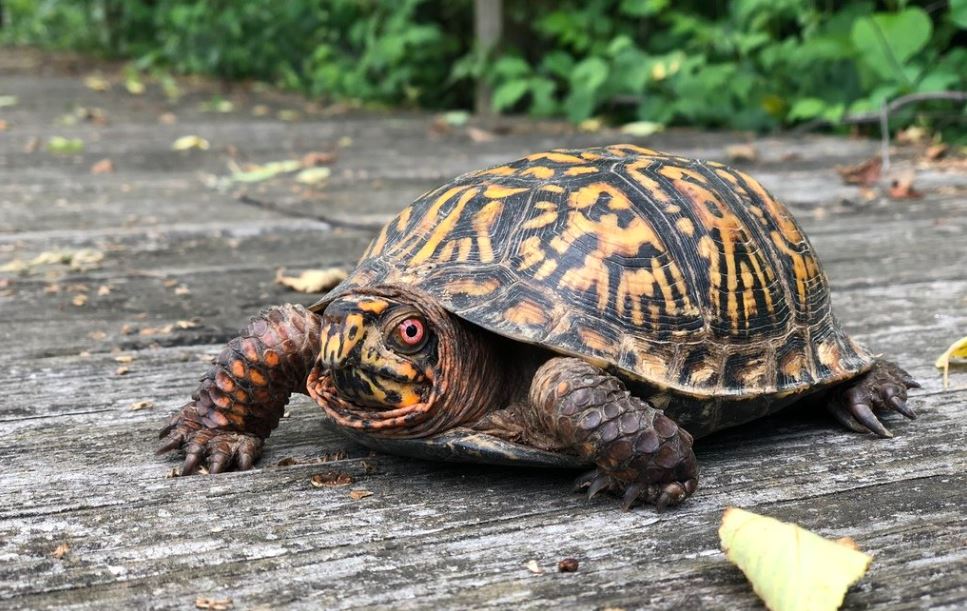
- Scientific Name: Terrapene carolina
- Conservation Status: Vulnerable
- Habitat: Eastern United States
Also referred to as the eastern box turtle, the common box turtle possesses a distinctive feature shared by all box turtles: a highly domed carapace (upper part of the shell) and a hinged plastron (lower part of the shell protecting the turtle’s undersides). This hinged plastron enables the turtle to fully retreat into its shell when faced with threats.
The common box turtle thrives in various habitats, including forests and grasslands, and may venture into water to cool down.
6. Chuckwalla (Common)

- Scientific Name: Sauromalus ater
- Conservation Status: Least Concern
- Habitat: Southwestern United States, Northwestern Mexico
Residing in the Sonoran and Mojave Deserts, the chuckwalla is a sizable lizard belonging to the iguana family, Iguanidae. Its appearance can vary, with individuals exhibiting dark black, brown, or green coloration. Notably, it possesses loose skin and a blunt tail.
Fear not, as the chuckwalla poses no harm to humans. When faced with danger, it seeks refuge in rocky crevices, wedging itself in by inflating its lungs.
7. Garter Snake (Common)
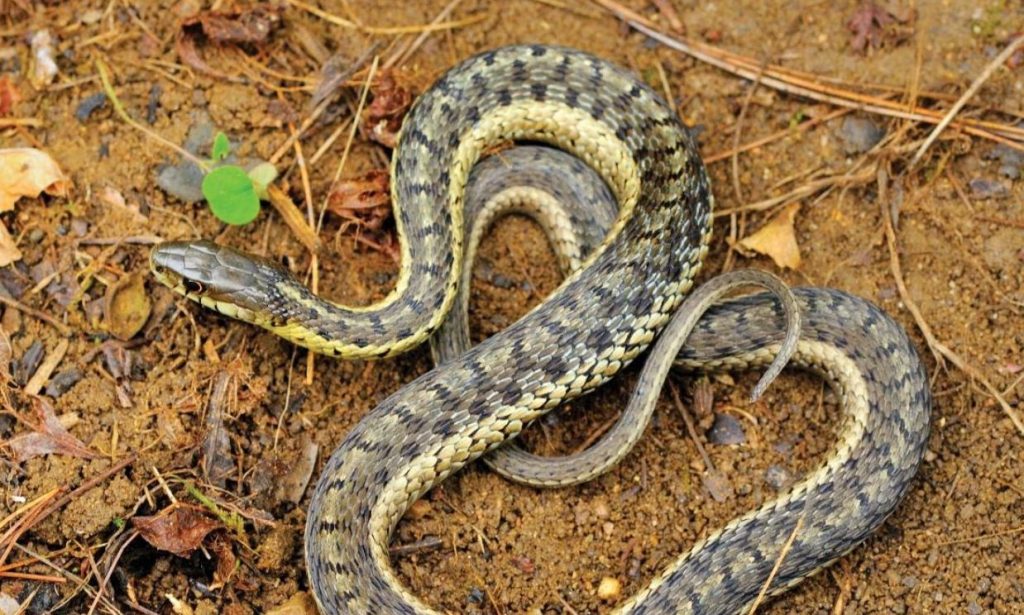
- Scientific Name: Thamnophis sirtalis
- Conservation Status: Least Concern
- Habitat: Various states, less common in the southwest
The common garter snake, a slender snake with an average length of about 22 inches (55 cm), showcases three distinctive yellow-brown stripes running along its body. Its brown background coloration is often accompanied by darker spots.
This species thrives in a range of habitats, including forests and wetlands, and is commonly found near bodies of water. While mildly venomous, the common garter snake does not pose a threat to humans and utilizes its venom for subduing prey and self-defense.
8. Copperhead
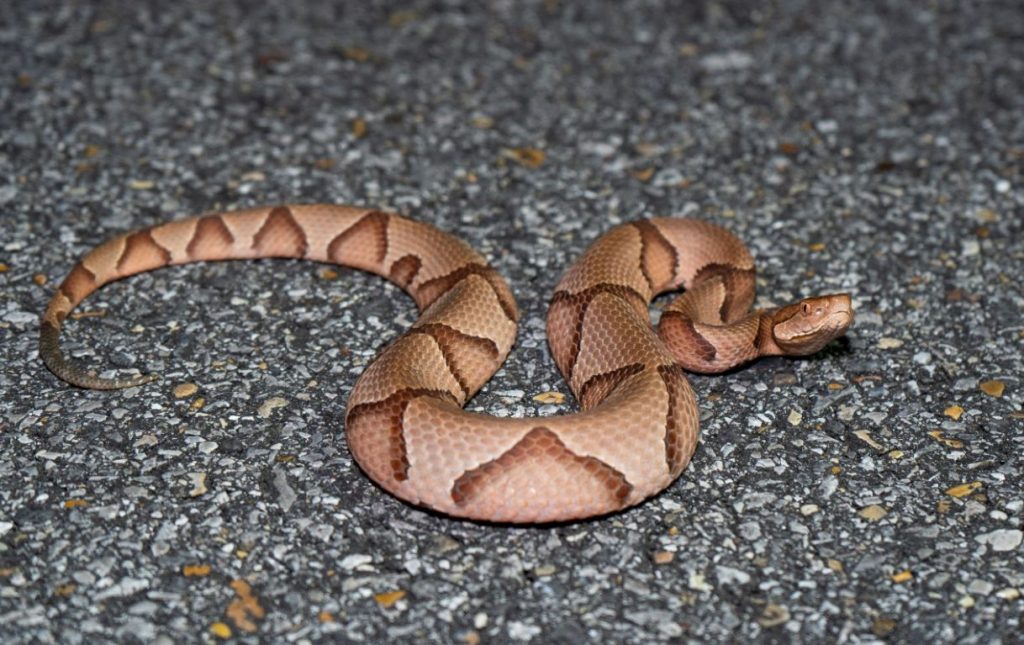
- Scientific Name: Agkistrodon contortrix
- Conservation Status: Least Concern
- Habitat: Eastern North America
Belonging to the snake subfamily Crotalinae, commonly known as pit vipers, the copperhead is a captivating reptile typically measuring between 2 and 4.5 feet (60 to 137 cm) in length. Its coppery-brown coloration is adorned with darker cross-bands along its body.
Forest and woodland environments serve as the primary habitats for the copperhead. While its bite is extremely painful, it is rarely fatal to humans. This venomous snake primarily preys on rodents.
9. Cottonmouth
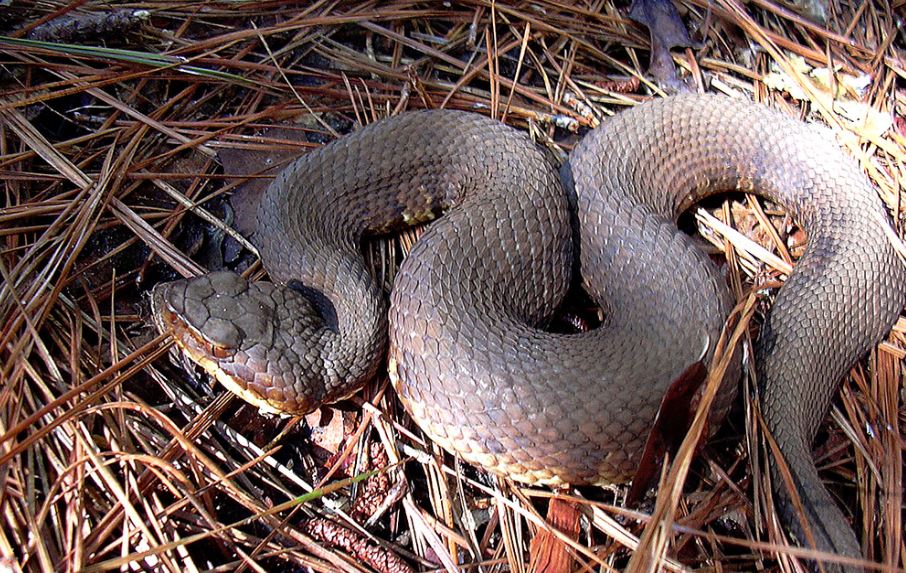
- Scientific Name: Agkistrodon piscivorus
- Conservation Status: Least Concern
- Habitat: Southeastern United States
Similar to the copperhead, the cottonmouth is a pit viper. It is also known as the water moccasin. This semiaquatic reptile can be found in swamps, streams, and lakes.
With a length ranging from 2 to 6 feet (60 to 182 cm), the cottonmouth sports a large head and a broad body. Its coloration typically ranges from black to tan with dark patterns, which may fade with age. The cottonmouth’s mouth has a distinctive white interior.
As a venomous snake, the cottonmouth’s bite has the potential to be fatal to humans, although such incidents are rare.
10. Diamondback Terrapin
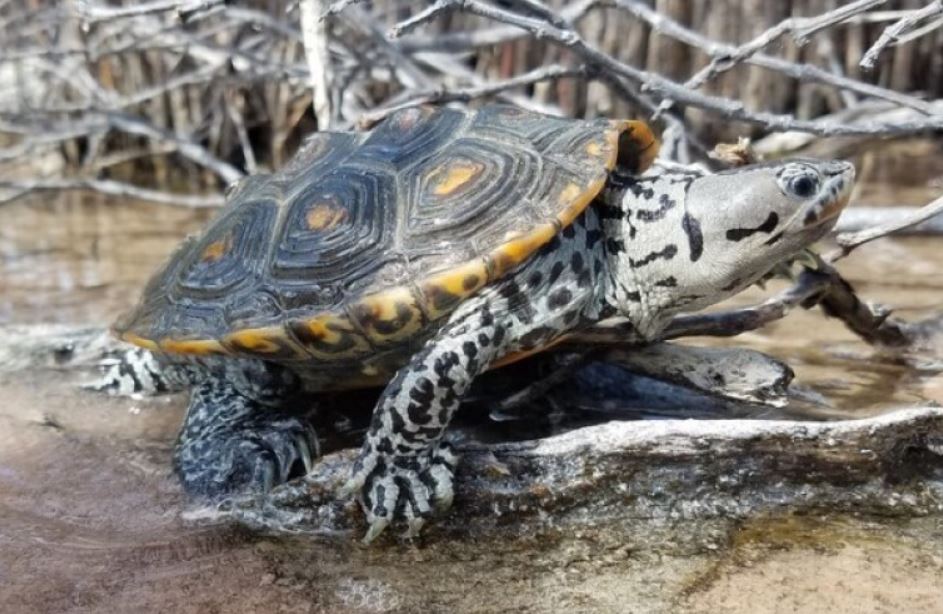
- Scientific Name: Malaclemys terrapin
- Conservation Status: Near Threatened
- Habitat: Eastern and southern United States, Bermuda
Spanning from the Florida Keys to Cape Cod, the diamondback terrapin boasts one of the broadest ranges among North American turtles (excluding sea turtles). It thrives in brackish coastal waters.
Female diamondback terrapins, reaching shell lengths of up to 9.5 inches (24 cm), can be twice the size of males. The name “diamondback” stems from the patterns adorning the upper part of its shell.
11. Eastern Coral Snake
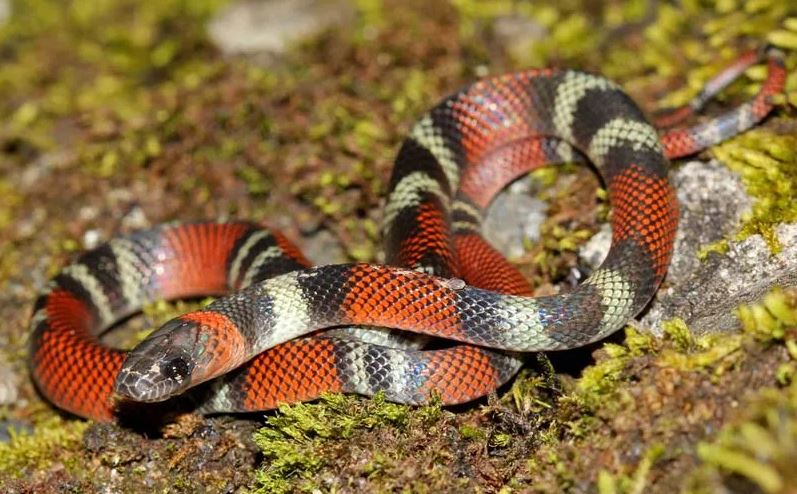
- Scientific Name: Micrurus fulvius
- Conservation Status: Least Concern
- Habitat: Southeastern United States
The eastern coral snake stands out with its vibrant and eye-catching appearance. Its body is adorned with red and black bands separated by narrower yellow bands. Ranging from 12 to 24 inches (61 to 122 cm) in length, it inhabits various environments, including woodlands and rocky hillsides.
Caution is warranted when encountering the eastern coral snake, as its bite has the potential to be fatal to humans.
12. Gila Monster
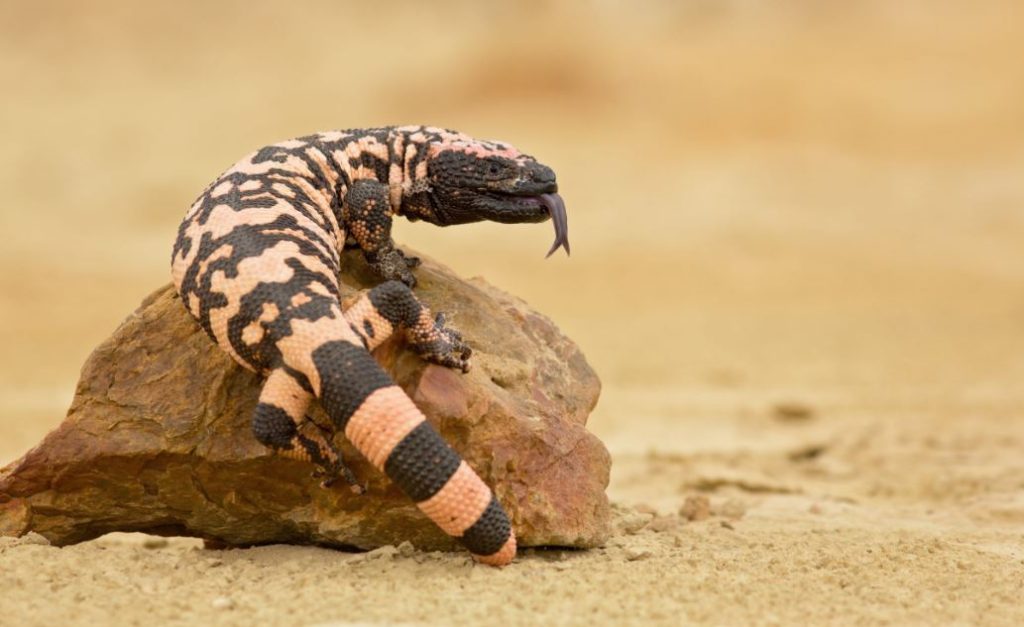
- Scientific Name: Heloderma suspectum
- Conservation Status: Near Threatened
- Habitat: Southwestern United States, northwestern Mexico
The Gila monster claims the title of the only venomous lizard found in the United States. With a stout body covered in bead-like scales, it sports yellow-orange coloration with blotchy black or brown patterns. Its tail is short and blunt.
Inhabiting desert habitats, the Gila monster utilizes its venom to capture small vertebrate prey, while also consuming insects and carrion. The distinctive color patterns serve as warning signals to deter predators. Though this slow-moving reptile possesses a fearsome reputation, its bites are rare and non-fatal to healthy humans.
For more intriguing insights into this species, refer to our comprehensive page: Gila Monster Facts.
13. Mojave Desert Tortoise
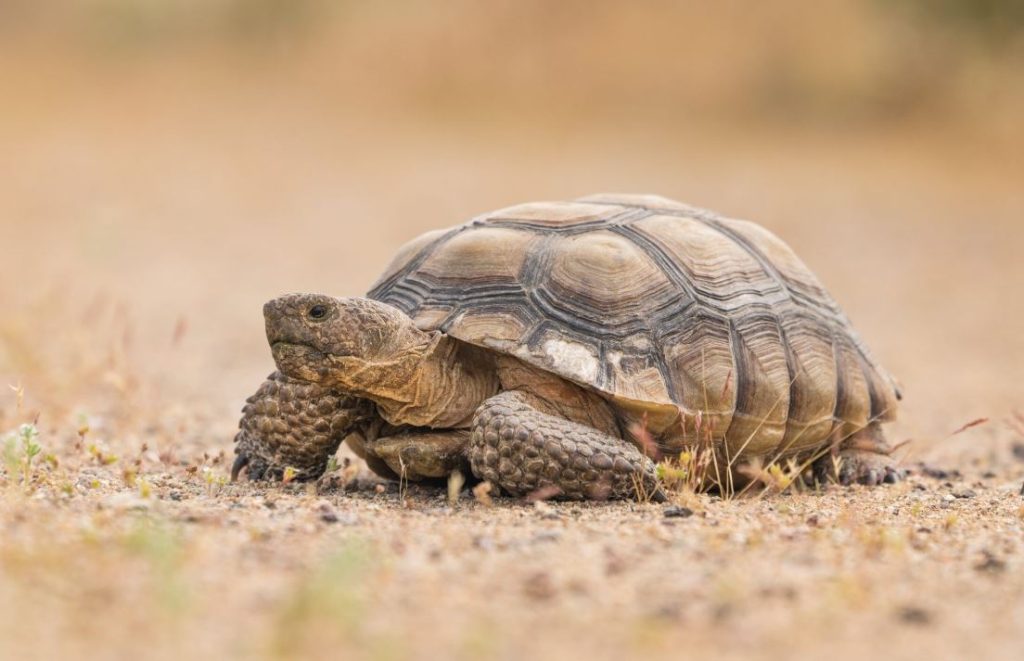
- Scientific Name: Gopherus agassizii
- Conservation Status: Critically Endangered
- Habitat: Southwestern United States, Northwestern Mexico
Thriving in the Mojave Desert, the Mojave desert tortoise shares a close relationship with the Sonoran desert tortoise, Gopherus morafkai. Until 2011, both were considered the same species—the desert tortoise.
With a shell length ranging from 9 to 14.5 inches (23 to 37 cm), this slow-moving herbivore possesses flattened front paws for efficient digging.
Discover more intriguing facts about this species through our comprehensive page: Desert Tortoise Facts.
14. Racer Snake (Eastern)
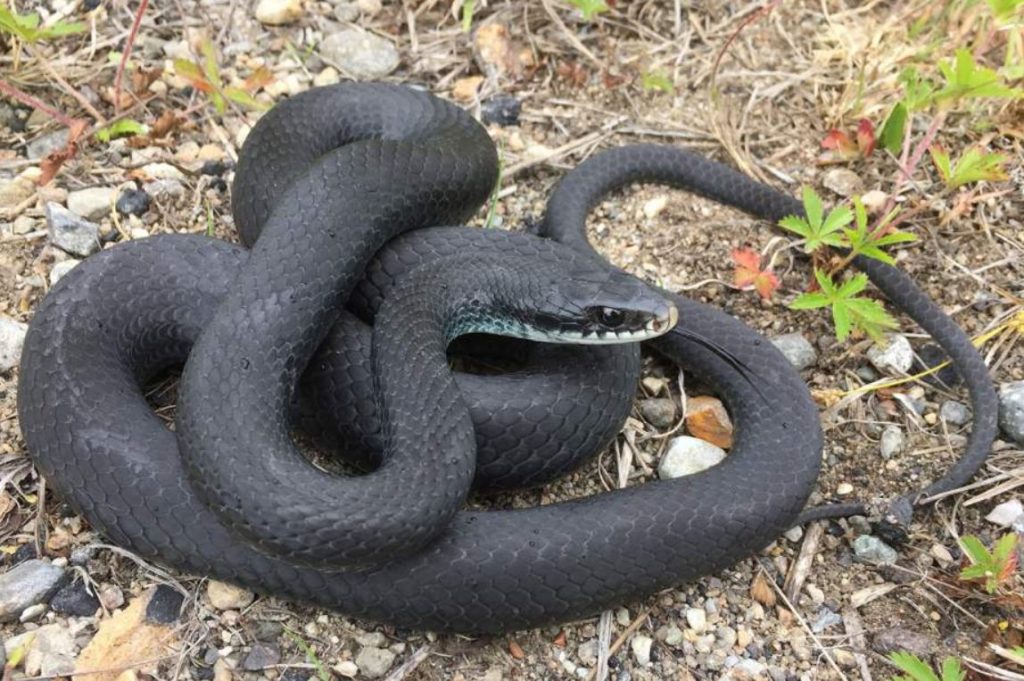
- Scientific Name: Coluber constrictor
- Conservation Status: Least Concern
- Habitat: United States, Southern Canada, Northern Mexico
The racer snake, earning its name from its remarkable speed and agility, can be found throughout much of the United States. With a length reaching approximately 60 inches (152 cm), this species exhibits color variations among its several subspecies.
Non-venomous in nature, the racer snake thrives in grassland habitats and is commonly encountered in suburban areas.
15. Ribbon Snake

- Scientific Name: Thamnophis sauritus
- Conservation Status: Least Concern
- Habitat: Eastern North United States, southern Canada
Belonging to the garter snake family, the ribbon snake is a slender reptile measuring no more than 3 feet (91 cm) in length. It showcases a striking appearance with three prominent yellow stripes running the length of its dark-colored body.
Although mildly venomous, the ribbon snake poses no threat to humans and is often kept as a pet. In the wild, it primarily feeds on invertebrates such as insects and worms.
16. Slender Glass Lizard
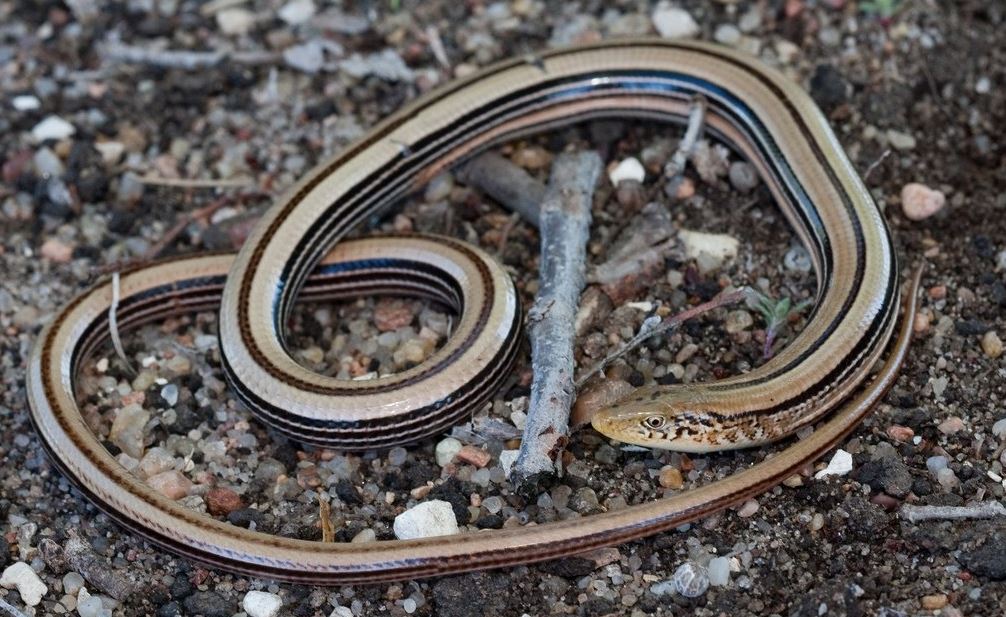
- Scientific Name: Ophisaurus attenuatus
- Conservation Status: Least Concern
- Habitat: Eastern United States
The slender glass lizard is a unique legless lizard that moves in a similar fashion to snakes. It can be found in grasslands and woodlands and is frequently spotted crossing roads.
One of its remarkable defense mechanisms is the ability to shed part of its tail if caught by a predator. Even when detached, the tail continues to move, serving as a distraction.
17. Stinkpot (Common Musk Turtle)
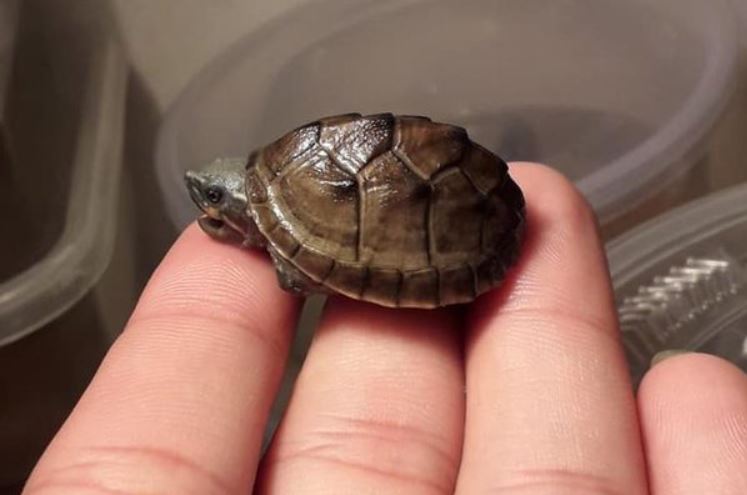
- Scientific Name: Sternotherus odoratus
- Conservation Status: Least Concern
- Habitat: Eastern United States, southeastern Canada
The stinkpot, a small turtle widely distributed across eastern North America, has a maximum shell length of approximately 5.5 inches (14 cm). Its smooth, highly domed shell is complemented by a pale stripe running along each side of the head.
Primarily dwelling in water, the stinkpot inhabits creeks, streams, and ponds. When threatened, it secretes a foul-smelling yellowish substance, acting as a defense mechanism.
18. Texas Horned Lizard
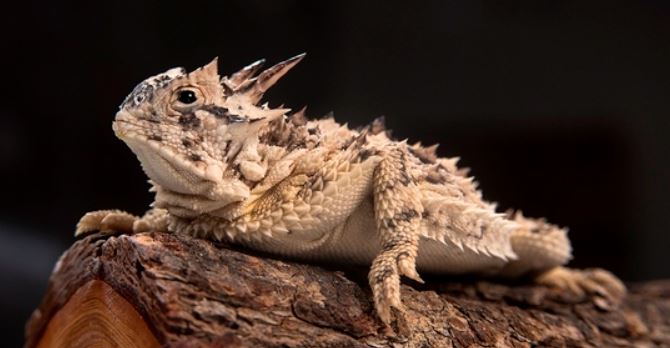
- Scientific Name: Phrynosoma cornutum
- Conservation Status: Least Concern
- Habitat: Southwestern United States, Northern Mexico
Reigning as the largest among the 22 recognized species of horned lizards, the Texas horned lizard often earns the misleading nickname “horny toad” due to its toad-like appearance.
Sporting a flattened, rounded body with gray or yellow-red-brown coloration, the Texas horned lizard’s back and tail are adorned with rows of sharp, spine-like scales. It possesses horns on its head made of bone.
In situations of peril, the Texas horned lizard has the extraordinary ability to squirt blood from its eyes, startling potential predators. The blood itself has a foul taste, further deterring canines and felines.
19. Western Banded Gecko
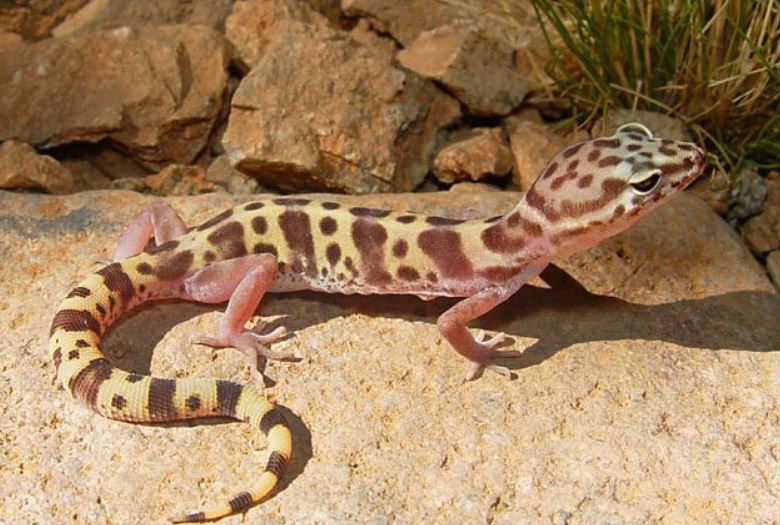
Scientific Name: Coleonyx variegatus
Conservation Status: Least Concern
Habitat: Southwestern United States, Northern Mexico
Thriving in dry desert, grassland, and rocky habitats, the western banded gecko exhibits a pale yellow-brown hue with darker stripes and spots.
As a nocturnal reptile, the western banded gecko feeds on insects and spiders. When threatened, it curls its tail over its back, resembling a scorpion. It can also detach its tail as a decoy if captured by a predator.
20. Western Diamondback Rattlesnake
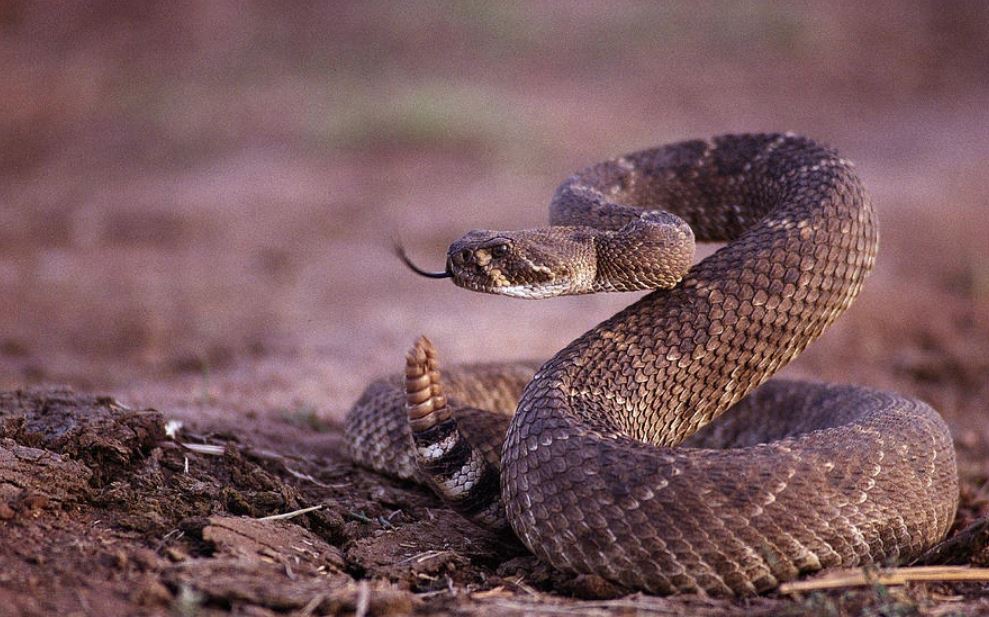
- Scientific Name: Crotalus atrox
- Conservation Status: Least Concern
- Habitat: Southwestern United States, Mexico
The western diamondback rattlesnake, a venomous snake, thrives in dry grasslands, deserts, and rocky areas. Its grey-brown coloration is adorned with a series of darker diamond-shaped patches outlined by pale borders. The tail displays several alternating black and white rings.
As a defensive mechanism, the western diamondback rattlesnake shakes its distinctive “rattle,” composed of dry scales at the tip of its tail, when faced with threats, emitting a warning sound.
While its bite has the potential to be fatal to humans, the western diamondback rattlesnake typically avoids confrontation unless provoked.
Explore the wonders of North American reptiles through these captivating images and fascinating facts. From the mighty alligator snapping turtle to the colorful Carolina anole, each reptile offers a unique glimpse into the diverse wildlife of North America.
Whether you’re intrigued by the incredible adaptations of reptiles like the chuckwalla and Texas horned lizard or fascinated by the venomous nature of snakes like the copperhead and cottonmouth, the world of North American reptiles is a treasure trove of discovery.
Take the time to explore the intricate details of each species, from the diamondback terrapin’s coastal habitat to the Mojave desert tortoise’s ability to thrive in arid environments.
While these reptiles may vary in size, color, and behavior, they all play important roles in their respective ecosystems. By understanding and appreciating the rich diversity of North American reptiles, we can contribute to their conservation and preservation for future generations to marvel at.
So dive into the world of North American reptiles, where the wonders of nature await your exploration.
